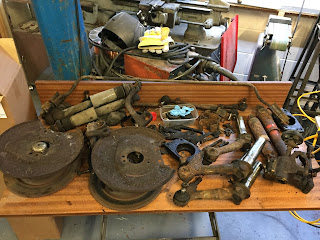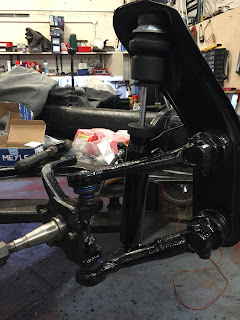The next stage was to make a start on rebuilding the bulkhead over the gearbox area. This particular area of metal is badly perforated but we decided that it made more sense to patch this area than try and replace the whole panel as it is under the car and over the gearbox and will never be seen. This will add more strength to the perforated areas, rather than cut them out and replace them.
The process for preparing under the car is as follows:
As we moved around to the back of the car, one area that needed attention was the bottom corner of the rear boot seal area. As you can see from the photo, the metalwork in this area had completely rotted away and had previously been rebuilt with body filler. This involved making several templates for five different pieces to fabricate the missing bits.
After some very careful welding the rebuilt corner was finally in place. Now true to form, just as I think that we are making progress a major problem is discovered.
After fitting the rubber seal and closing the engine cover lid, it was discovered that there was a 2cm difference between the body and the engine cover lid on opposite corners. After investigation it was revealed that the whole left hand corner of the body had been pushed forward during a previous accident and instead of pulling it out during that repair, they had simply made up the difference with vast thicknesses of body filler. Now with the filler removed the true extent of the damage was revealed.
The very hard decision was made to turn the body back upside down, cut all of the welds to all of the panels in the rear quarter, including the engine compartment and then use a hydraulic ram to push the offending rear panel out to the correct position so that the engine compartment lid fit properly. This was done and then all of the connecting panels were rewelded. This whole process took 6 hours to do, but at least it is now right.
Well only two more bits to do and then the body can be transported back to my workshop, and that is fitting the headlight bowls. This involved some very delicate TIG welding so that the welds did not interfere with the headlight rims.
So after two and a half years, at last, the body was transferred onto the transporter and it was on it's way home!
With the body finally back home, I can now concentrate on preparing the body for paint. This will require a good deal of preparation on the underside before progressing to the upper bodywork. I'm under no illusion, the first and worst job will be to remove 50 year old underseal from the original panels that have not needed replacing and I am sure that this will reveal more holes and more welding needed.
Remove old underseal with a heat gun and scraper.
Rotary wire brush to remove remaining debris and rust.
Treat with rust killer (Black)
Seam Seal all joints
Spray with deep etch undercoat paint (grey)
Spray with Stone Chip paint. (White)
When the car finally goes to the paint shop it will receive a full undercoat over all surfaces and then a final top coat colour.
Well that's it for now, much more to come.
You can contact me on hopcroftscoot@gmail.com
Copyright 03.12.20 all rights reserved.
My Other Blogs:
1961 BSA A10 Super Rocket Motorcycle:
http://60sclassicmotorbikes.blogspot.com/2012/07/before.html
1961 Ariel Arrow Super Sport Motorcycle :
http://60sclassicmotorbikes.blogspot.com/2014/01/1961-aerial-golden-arrow-restoration.html
Miniature Land Rover Defender:
http://miniaturelandrover.blogspot.com/2016/02/1-miniature-land-rover-defender-idea.html?view=timeslide
Motorcycle Trailers / Caravans:
http://motorcycletrailersandcaravans.blogspot.com/2018/01/1-motorcycle-trailers-problem.html
Copyright 03.12.20 all rights reserved.
My Other Blogs:
1961 BSA A10 Super Rocket Motorcycle:
http://60sclassicmotorbikes.blogspot.com/2012/07/before.html
1961 Ariel Arrow Super Sport Motorcycle :
http://60sclassicmotorbikes.blogspot.com/2014/01/1961-aerial-golden-arrow-restoration.html
Miniature Land Rover Defender:
http://miniaturelandrover.blogspot.com/2016/02/1-miniature-land-rover-defender-idea.html?view=timeslide
Motorcycle Trailers / Caravans:
http://motorcycletrailersandcaravans.blogspot.com/2018/01/1-motorcycle-trailers-problem.html




















































